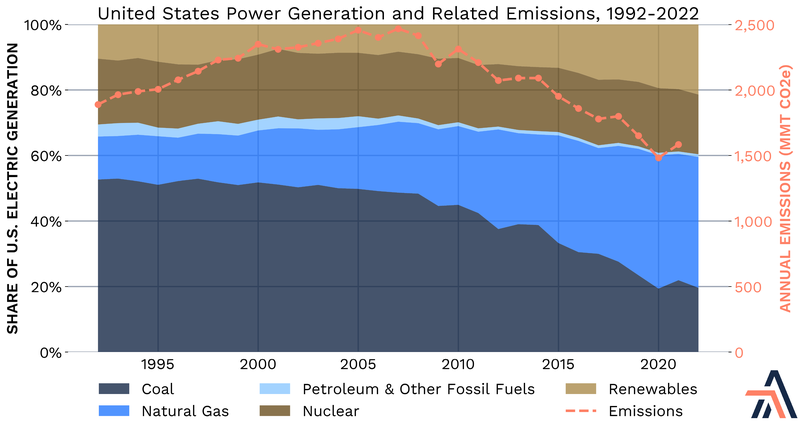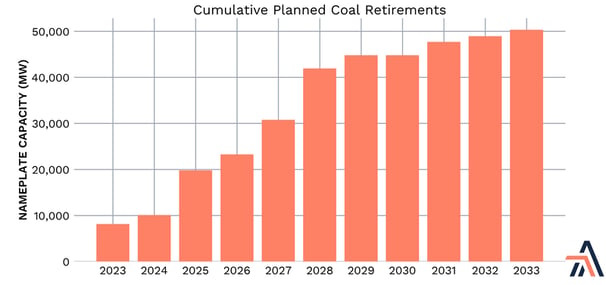Coal to Gas: Energy Evolution Stage One
Originally published for customers May 3, 2023
What’s the issue?
The energy evolution in the United States is moving full steam ahead, with many hoping to leave fossil fuels behind altogether. Natural gas has made a strong case for itself by displacing a significant amount of coal-fired generation, directly leading to decreasing emissions in the electric power sector.
Why does it matter?
New renewable generation facilities and massive grid upgrades will be required in order to transition away from fossil fuels completely, and these projects currently face a number of hurdles. Natural gas infrastructure, on the other hand, already exists in much of the country and can easily meet the country’s growing electricity demands.
What’s our view?
Natural gas simply cannot be left behind if the U.S. hopes to achieve a successful energy evolution. It will play a key role in ensuring that both electricity demands and emissions goals are met.
The energy evolution in the United States is moving full steam ahead, with many hoping to leave fossil fuels behind altogether. Natural gas has made a strong case for itself by displacing a significant amount of coal-fired generation, directly leading to decreasing emissions in the electric power sector. New renewable generation facilities and massive grid upgrades will be required in order to transition away from fossil fuels completely, and these projects currently face a number of hurdles. Natural gas infrastructure, on the other hand, already exists in much of the country and can easily meet the country’s growing electricity demands.
Natural gas simply cannot be left behind if the U.S. hopes to achieve a successful energy evolution. It will play a key role in ensuring that both electricity demands and emissions goals are met.
Natural Gas Generation is Increasing, Emissions Are Not
Reducing overall emissions from the power sector and, more broadly, the energy industry as a whole is one of the energy evolution’s main goals. The U.S.’s electric power sector has already undergone a relatively significant transition in the past two decades and, as a result, has seen greenhouse gas (GHG) emissions fall by over a third from their peak in 2007. This has been achieved relatively easily by replacing a significant amount of coal-fired generation with much more cleanly burning natural gas-fired generation facilities.

As seen in the chart above, coal-fired generation accounted for 52% of the electric generation in the U.S. in 1992. When the electric power sector’s GHG emission levels were at their highest, coal was being used to generate 48% of the U.S.’s electricity. Since then, the utilization of coal has fallen drastically, accounting for only 20% of electric generation last year. According to the EPA, however, this generation accounted for 59% of the sector’s emissions. As a result of the shale revolution, natural gas’s utilization for power generation has been able to rapidly rise. It now accounts for 40% of the country’s total electric generation and GHG emissions have fallen by more than a third in this timeframe.
Dedicated Coal to Gas Switching
The decrease in coal generation is directly attributed to the decrease in available coal-fired generation capacity. In many cases, coal plants are simply retiring. There are two situations where natural gas has directly replaced this generation: existing coal plants are retired and then replaced by a natural gas-fired plant or the coal plant’s boiler is converted to burn other types of fuels, most frequently natural gas. Most of the decrease in generation capacity has been due to complete retirements, but a significant amount of the decreases have been due to the combination of boiler conversions and natural gas replacements.
According to the U.S. Energy Information Administration (EIA), coal-fired plants in the eastern U.S. are often good candidates for conversion due to their smaller-capacity units and age. There were 104 of these candidate units at the beginning of 2010, 86 of which have already been converted.
Coal Retirements
Regardless of the GHG emissions that result from burning coal to generate electricity, the facilities are already built, connected to the grid, and generate reliable and consistent amounts of electricity, which are the main problems that new renewable infrastructure are facing. In The Grid Will Be Better, But When?, we discuss that grid upgrades and expansion will play a key role in transporting renewable generation to where it is needed, but at this point in time, there are currently not enough transmission projects in the hopper to meet these needs. In MISO Shows Reforms Are Desperately Needed to Interconnection Queueing, we discuss the major delays that the interconnection queueing process is causing for planned renewable generation projects. These problems will need to be addressed in order to successfully integrate the significant amounts of renewable capacity that will be needed for the energy evolution. Until that time, however, fossil fuels will need to continue to be utilized in order to ensure that our electricity demands are met.

There are currently 500 operating coal plants across the U.S., accounting for 212 GW of nameplate capacity. More than 100 of those coal plants have a planned retirement date in the next ten years, which will eliminate almost a quarter of the remaining coal-fired capacity in the country. These retirements will further reduce emissions from the power sector. Looming issues for renewable projects and transmission at the very least provide many opportunities for growing natural gas generation in the next decade.
Opportunities Vary By Region
Above, we mentioned that the EIA has stated that many existing coal plants in the eastern part of the country are excellent candidates for retiring and being directly replaced with natural gas generation facilities. As a whole, the U.S. has replaced a significant amount of coal-fired generation with natural gas, but this isn’t necessarily the case when we focus on individual regions of the country.

As seen in the chart above, there are still regions of the country that utilize a significant amount of coal in order to generate electricity. New England and the Pacific Northwest never utilized much to begin with, and as a result, have not seen significant increases in the amount of natural gas used to generate electricity that many other regions have. It certainly isn’t a secret that California could likely benefit from increasing their natural gas consumption in order to meet electricity demand, but the chances of that are slim to none.
The South Atlantic region, which encompasses the states along the East Coast from Delaware through Florida, has cut its coal consumption by more than half and almost tripled natural gas consumption in the same time period. North Carolina is just one of the states in this region that has made concrete goals through legislation to retire its remaining operating coal plants. If these states are not able to make up for the lost capacity through renewable projects in the near future, it is likely that the reliance on natural gas in this region will continue to increase.
The East North Central region has also halved its coal consumption and doubled its natural gas consumption in the electric power sector since the start of the shale revolution. The EIA defines this region as Wisconsin, Michigan, Illinois, Indiana, and Ohio. All of these states, except Ohio, are a part of MISO. As we discussed in MISO Shows Reforms Are Desperately Needed to Interconnection Queueing, there is over 200 GW of mostly renewable planned capacity in MISO’s queue that is intended to go into service in the next 10 years. However, we do not foresee much of that capacity successfully completing the interconnection queue process and being complete for commercial operation by then. Existing natural gas generation will almost certainly be needed to make up the gap.
In many areas of the country, natural gas has already firmly replaced coal as a major source of electricity generation. It burns much more cleanly than coal. While renewable generation is certainly better than any fossil fuels when it comes to emissions, the fact that natural gas infrastructure already exists and provides much more reliable power generation cannot be ignored. Natural gas has already proven itself as a logical stepping stone and key player in the energy evolution.